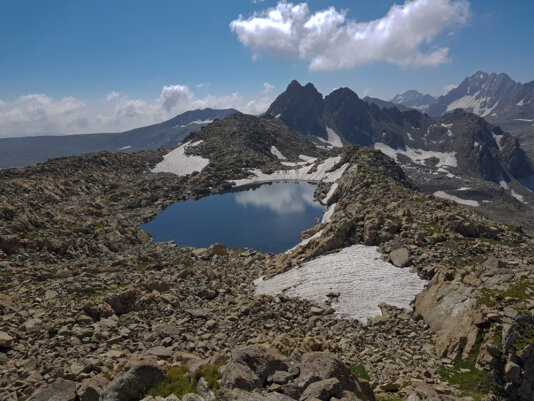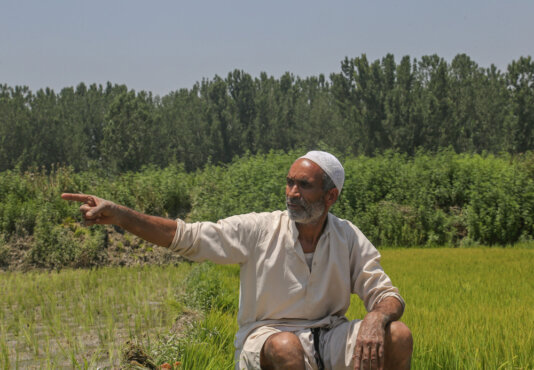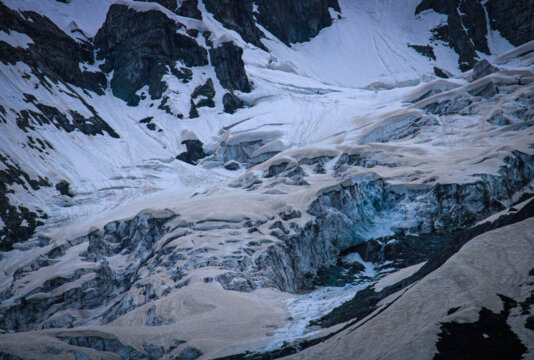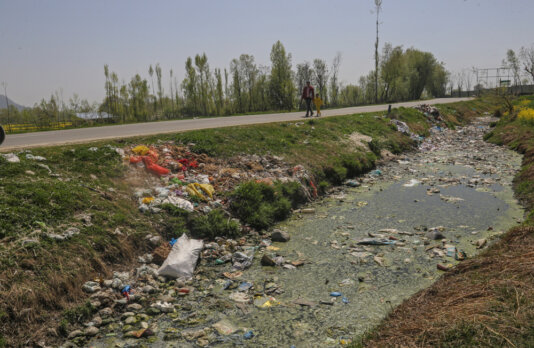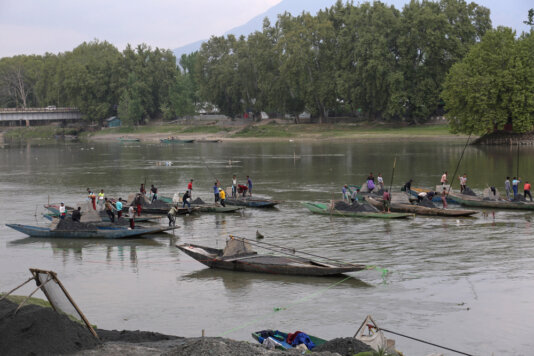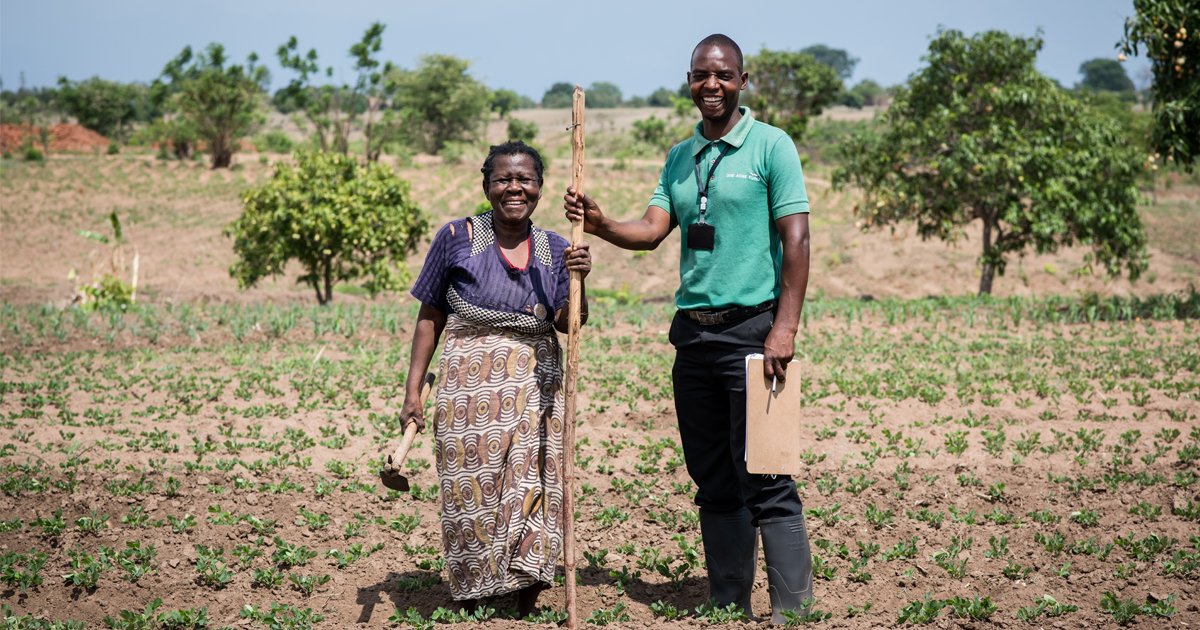- About
- Topics
- Picks
- Audio
- Story
- In-Depth
- Opinion
- News
- Donate
- Signup for our newsletterOur Editors' Best Picks.Send
Read, Debate: Engage.
| July 17, 2022 | |
|---|---|
| topic: | Climate Change |
| tags: | #Kashmir, #droughts, #farming, #climate change, #Sustainable Agriculture |
| located: | India |
| by: | Sajad Hameed, Malik Nisar |
Mohammad Aslam, a young farmer from Anantnag, gets goosebumps whenever he visits his farmland. The once lush green field has turned barren due to a scarcity of water.
"Because of the unavailability of water, we could not do paddy cultivation. This is a total catastrophe since paddy cultivation is the sole source of income for us," said Aslam while walking on the roadside, carrying a heap of grass on his back.
As reported by Hindustan Times, Kashmir recorded 80 percent less rainfall than normal this year, which led to an increase in temperatures.
In the twin districts of Anantnag and Pulwama, more than 26,000 canals connected to paddy farmland got affected due to the severe drought, leaving many farmers in a state of shock. Numerous pumps at lelhar village are currently dysfunctional, and although the irrigation department provided new ones, this resulted in no change on the ground.
"The receding water levels in the rivers have made lift irrigation schemes defunct," said 56-year-old Ghulam Rasool Yatoo, a farmer from lelhar. "I have never witnessed this amount of loss in my life till date. Presently, water bodies are shrinking at a higher pace."
lelhar village is home to nearly 600 households. Among them, 70 percent depend on agriculture for survival.
"No compensation is due for us. This village has suffered the most among others, as it is completely dependent on the agribusiness. The droughts have brought our life to a standstill," Yatoo told FairPlanet.
The situation is equally as grim in the Northern part of Kashmir. In Haritar village in Sopore and the Pattan area of Baramulla District, more than 5,000 canals got severely affected by the lack of water and streams have dried up. "We don't have alternative means of irrigation other than rain," said Abdul Gaffar Niak from Haritar. "We are inching towards a huge loss."
"The droughts have brought our life to a standstill."
According to the Drought in Numbers 2022 report, India is among the countries most severely impacted by droughts. Nearly two-thirds of the country had experienced droughts between 2020 and 2022. The report further states that India's Gross Domestic Product (GDP) had plummeted by 2 to 5 percent between 1998 and 2017 as a result of severe droughts.
Irshad Ahmad Dar, a resident of Patalbagh, Pulwama and member of the Kisans Advisory Board, has been regularly checking the progressive development in agriculture fields. But to his utter dismay, all he found was a decrease in production since last year.
The Kisans advisory board of Jammu and Kashmir is a governmental entity monitoring the region's agricultural developments and supporting local farmers by responding to their requests and identifying issues that affect them.
According to Dar, over the past few years Kashmir has been facing acute water shortages and other issues that adversely affect agriculture in the region. "The government provided bore-wells in the village for the enrichment of fields. As the place faces scarcity of water, the government is trying to bring sustainable development into consideration," Dar, who also owns large swathes of land in Pulwama, told FairPlanet.
"Many crops have been damaged and agricultural production has continuously decreased," he added. "There is acute water scarcity but the fields shouldn't be left unattended. We are trying to encourage farmers to sow lentil and wheat."
Dar went on to say that climate change is the main reason for the shortage of water in Kashmir, but added that development is also to blame. "Jhelum is [the region's] main water source. Due to encroachment and sand mining water levels are decreasing in rivers and streams.
"Farmers have lost a hefty amount of money due to low productivity or, at times, no productivity at all," Dar said, adding that his advisory board "will make a complete report of farms and farmers," and projecting that it will be "quite beneficial. If not 100 percent then at least up to 60-70 percent."
Chowdhury Mohammad Iqbal, Kashmir's Director of Agriculture, believes the biggest changes in Temperature can be anticipated in the middle of the vegetation session (summer), with an increase of 0.8-1°C.
"A decline of precipitation somewhere in the range of 2 and 8 percent is anticipated over the bigger part of Kashmir. Thus, higher evapotranspiration requests and diminished normal precipitations could additionally worsen water imbalances in the agro ecosystems on the expounded region," Iqbal told FairPlanet.
He went on to say that gathering multi-year climate, soil and water data might give a decent premise to the dynamic cycle in forging sustainable agriculture strategies, developing proper water system frameworks and utilising the current water system to gather precipitation.
"Agrarian practices alongside other allied agricultural activities have ended up being helpful to farmers in Kashmir, as well as all over the world," said Iqbal. "Integrated farming is one of the models that is being executed in the Agricultural Systems of Kashmir, wherein farming is incorporated with animals, poultry and fish [...] to produce work around the year and, furthermore, get extra income."
According to Iqbal, the Department of Agriculture is observing the circumstances intently and the impacted farmers would be appropriately remunerated through the government's Disaster Management Plans.
"Farmers need to take on a 'more-yield-per-drop' approach with the goal that the most extreme result could be raised in the midst of present situations," Iqbal said. "Make sustainable agriculture development of the fitting water system frameworks, utilise the dry season [with] intensity lenient yields, cultivars and mixtures and use strategies to keep up soil dampness by reducing evaporation," is Iqbal's message to farmers.
Dr Raihana Habib Kanth, a dean at Sher-e-Kashmir University of Agricultural Sciences and Technology' s Department of Agronomy, mentioned that deforestation is a significant driver of climate change. "The impact of global warming as temperature boosts the carbon dioxide level is getting expanded because of less plantation, [and] glaciers in the valley are melting at an alarming rate," Dr Kanth told FairPlanet.
She went on to say that agriculture production will be impacted by rising temperatures, changing rainfall patterns and more frequent and acute climate events; these will directly affect crop development and advancement. "The climbing temperature causes early blooming, which prompts drastic decrease in the yield," she said. "[The relevant] departments should incorporate awareness camps to be coordinated about the changing environment situation and viewing the executives of the crops as suggested by researchers and scientists.
"Sustainable farming practices that have been created and effectively defeat the effect of environmental change ought to be carried out."
"We need developed farm practices and the executives," she concluded. "Irrigated cropping system, integrated crops and livestock and aquaponic production system management will hugely help the agricultural system."
Image by Sajad Hameed and Malik Nisar.
By copying the embed code below, you agree to adhere to our republishing guidelines.
